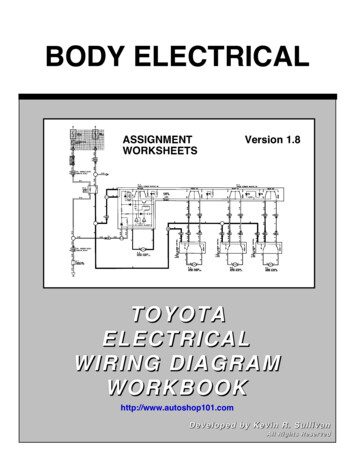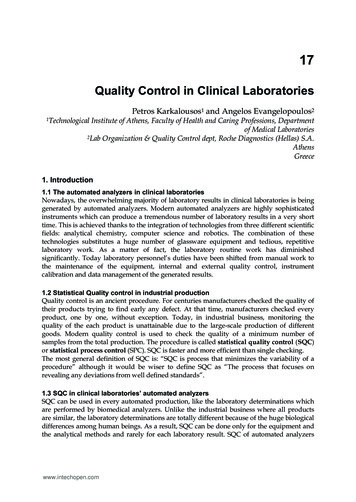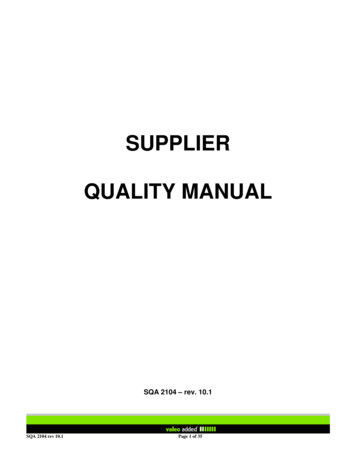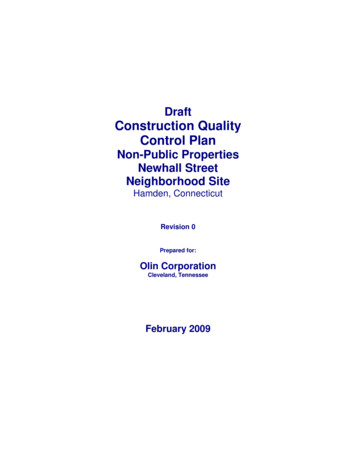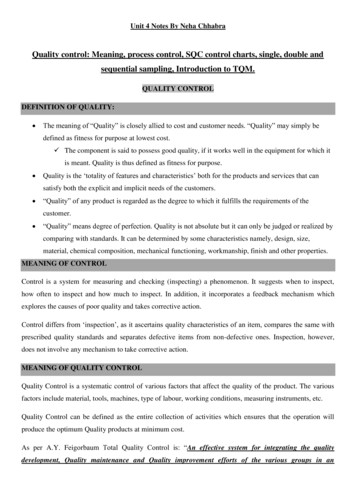
Transcription
Unit 4 Notes By Neha ChhabraQuality control: Meaning, process control, SQC control charts, single, double andsequential sampling, Introduction to TQM.QUALITY CONTROLDEFINITION OF QUALITY: The meaning of “Quality” is closely allied to cost and customer needs. “Quality” may simply bedefined as fitness for purpose at lowest cost. The component is said to possess good quality, if it works well in the equipment for which itis meant. Quality is thus defined as fitness for purpose. Quality is the ‘totality of features and characteristics’ both for the products and services that cansatisfy both the explicit and implicit needs of the customers. “Quality” of any product is regarded as the degree to which it fulfills the requirements of thecustomer. “Quality” means degree of perfection. Quality is not absolute but it can only be judged or realized bycomparing with standards. It can be determined by some characteristics namely, design, size,material, chemical composition, mechanical functioning, workmanship, finish and other properties.MEANING OF CONTROLControl is a system for measuring and checking (inspecting) a phenomenon. It suggests when to inspect,how often to inspect and how much to inspect. In addition, it incorporates a feedback mechanism whichexplores the causes of poor quality and takes corrective action.Control differs from ‘inspection’, as it ascertains quality characteristics of an item, compares the same withprescribed quality standards and separates defective items from non-defective ones. Inspection, however,does not involve any mechanism to take corrective action.MEANING OF QUALITY CONTROLQuality Control is a systematic control of various factors that affect the quality of the product. The variousfactors include material, tools, machines, type of labour, working conditions, measuring instruments, etc.Quality Control can be defined as the entire collection of activities which ensures that the operation willproduce the optimum Quality products at minimum cost.As per A.Y. Feigorbaum Total Quality Control is: “An effective system for integrating the qualitydevelopment, Quality maintenance and Quality improvement efforts of the various groups in an
organization, so as to enable production and services at the most economical levels which allow fullcustomer satisfaction”In the words of Alford and Beatly, “Quality Control” may be broadly defined as that “Industrialmanagement technique means of which products of uniform accepted quality are manufactured.” QualityControl is concerned with making things right rather than discovering and rejecting those made wrong.In short, we can say that quality control is a technique of management for achieving required standards ofproducts.FACTORS AFFECTING QUALITYIn addition to men, materials, machines and manufacturing conditions there are some other factorswhich affect the product quality. These are: Market Research i.e. indepth into demands of purchaser. Money i.e. capability to invest. Management i.e. Management policies for quality level. Production methods and product design.Modern quality control begins with an evaluation of the customer’s requirements and has a part to play atevery stage from goods manufactured right through sales to a customer, who remains satisfied.OBJECTIVES OF QUALITY CONTROL To decide about the standard of quality of a product that is easily acceptable to the customer andat the same time this standard should be economical to maintain. To take different measures to improve the standard of quality of product. To take various steps to solve any kind of deviations in the quality of the product duringmanufacturing.FUNCTIONS OF QUALITY CONTROL DEPARTMENT Only the products of uniform and standard quality are allowed to be sold. To suggest method and ways to prevent the manufacturing difficulties. To reject the defective goods so that the products of poor quality may not reach to the customers. To find out the points where the control is breaking down and to investigate the causes of it. To correct the rejected goods, if it is possible. This procedure is known as rehabilitation ofdefective goods.
ADVANTAGES OF QUALITY CONTROL Quality of product is improved which in turn increases sales. Scrap rejection and rework are minimized thus reducing wastage. So the cost of manufacturingreduces. Good quality product improves reputation. Inspection cost reduces to a great extent. Uniformity in quality can be achieved. Improvement in manufacturer and consumer relations.STATISTICAL QUALITY CONTROL (S.Q.C): Statistics: Statistics means data, a good amount of data to obtain reliable results. The science ofstatistics handles this data in order to draw certain conclusions. S.Q.C: This is a quality control system employing the statistical techniques to control quality byperforming inspection, testing and analysis to conclude whether the quality of the product is as perthe laid quality standards.Using statistical techniques, S.Q.C. collects and analyses data in assessing and controlling productquality. The technique of S.Q.C. was though developed in 1924 by Dr.WalterA.Shewartan Americanscientist; it got recognition in industry only second world war. The technique permits a morefundamental control.“Statistical quality control can be simply defined as an economic & effective system of maintaining &improving the quality of outputs throughout the whole operating process of specification, production& inspection based on continuous testing with random samples.”-YA LUN CHOU“Statistical quality control should be viewed as a kit of tools which may influence decisions to thefunctions of specification, production or inspection.-EUGENE L. GRANTThe fundamental basis of S.Q.C. is the theory of probability. According to the theories of probability, thedimensions of the components made on the same machine and in one batch (if measured accurately) varyfrom component to component. This may be due to inherent machine characteristics or theenvironmental conditions. The chance or condition that a sample will represent the entire batch orpopulation is developed from the theory of probability.Relying itself on the probability theory, S.Q.C. evaluates batch quality and controls the quality ofprocesses and products. S.Q.C. uses three scientific techniques, namely;
Sampling inspection Analysis of the data, and Control chartingADVANTAGES OF S.Q.CS.Q.C is one of the tool for scientific management, and has following main advantages over 100 percentinspection: Reduction in cost: Since only a fractional output is inspected, hence cost of inspection is greatlyreduced. Greater efficiency: It requires lesser time and boredom as compared to the 100 percentinspection and hence the efficiency increases. Easy to apply: Once the S.Q.C plan is established, it is easy to apply even by man who does nothave extensive specialized training. Accurate prediction: Specifications can easily be predicted for the future, which is not possibleeven with 100 percent inspection. Can be used where inspection is needs destruction of items: In cases where destruction ofproduct is necessary for inspecting it, 100 percent inspection is not possible (which will spoil allthe products), sampling inspection is resorted to. Early detection of faults: The moment a sample point falls outside the control limits, it is takenas a danger signal and necessary corrective measures are taken. Whereas in 100 percentinspection, unwanted variations in quality may be detected after large number of defective itemshave already been produced. Thus by using the control charts, we can know from graphic picturethat how the production is proceeding and where corrective action is required and where it is notrequired.PROCESS CONTROLUnder this the quality of the products is controlled while the products are in the process of production.The process control is secured with the technique of control charts. Control charts are also used in thefield of advertising, packing etc. They ensure that whether the products confirm to the specified qualitystandard or not.Process Control consists of the systems and tools used to ensure that processes are well defined, performedcorrectly, and maintained so that the completed product conforms to established requirements. ProcessControl is an essential element of managing risk to ensure the safety and reliability of the Space ShuttleProgram. It is recognized that strict process control practices will aid in the prevention of process escapesthat may result in or contribute to in-flight anomalies, mishaps, incidents and non-conformances.
The five elements of a process are: People – skilled individuals who understand the importance of process and change control Methods/Instructions – documented techniques used to define and perform a process Equipment – tools, fixtures, facilities required to make products that meet requirements Material – both product and process materials used to manufacture and test products Environment – environmental conditions required to properly manufacture and test productsPROCESS CONTROL SYSTEMS FORMSProcess control systems can be characterized as one or more of the following forms: Discrete – Found in many manufacturing, motion and packaging applications. Robotic assembly,such as that found in automotive production, can be characterized as discrete process control.Most discrete manufacturing involves the production of discrete pieces of product, such as metalstamping. Batch – Some applications require that specific quantities of raw materials be combined inspecific ways for particular durations to produce an intermediate or end result. One example isthe production of adhesives and glues, which normally require the mixing of raw materials in aheated vessel for a period of time to form a quantity of end product. Other important examplesare the production of food, beverages and medicine. Batch processes are generally used toproduce a relatively low to intermediate quantity of product per year (a few pounds to millions ofpounds). Continuous – Often, a physical system is represented through variables that are smooth anduninterrupted in time. The control of the water temperature in a heating jacket, for example, is anexample of continuous process control. Some important continuous processes are the productionof fuels, chemicals and plastics. Continuous processes in manufacturing are used to produce verylarge quantities of product per year (millions to billions of pounds).STATISTICAL PROCESS CONTROL (SPC)SPC is an effective method of monitoring a process through the use of control charts. Much of its power liesin the ability to monitor both process center and its variation about that center. By collecting data fromsamples at various points within the process, variations in the process that may affect the quality of the endproduct or service can be detected and corrected, thus reducing waste as well as the likelihood that problemswill be passed on to the customer. It has an emphasis on early detection and prevention of problems.
CONTROL CHARTSSince variations in manufacturing process are unavoidable, the control chart tells when to leave a processalone and thus prevent unnecessary frequent adjustments. Control charts are graphical representation and arebased on statistical sampling theory, according to which an adequate sized random sample is drawn fromeach lot. Control charts detect variations in the processing and warn if there is any departure from thespecified tolerance limits. These control charts immediately tell the undesired variations and help indetecting the cause and its removal.In control charts, where both upper and lower values are specified for a quality characteristic, as soon assome products show variation outside the tolerances, a review of situation is taken and corrective step isimmediately taken.If analysis of the control chart indicates that the process is currently under control (i.e. is stable, withvariation only coming from sources common to the process) then data from the process can be used topredict the future performance of the process. If the chart indicates that the process being monitored is not incontrol, analysis of the chart can help determine the sources of variation, which can then be eliminated tobring the process back into control. A control chart is a specific kind of run chart that allows significantchange to be differentiated from the natural variability of the process.The control chart can be seen as part of an objective and disciplined approach that enables correct decisionsregarding control of the process, including whether or not to change process control parameters. Processparameters should never be adjusted for a process that is in control, as this will result in degraded processperformance.In other words, control chart is: A device which specifies the state of statistical control, A device for attaining statistical control, A device to judge whether statistical control has been attained or not.PURPOSE AND ADVANTAGES:1. A control charts indicates whether the process is in control or out of control.2. It determines process variability and detects unusual variations taking place in a process.3. It ensures product quality level.4. It warns in time, and if the process is rectified at that time, scrap or percentage rejection can bereduced.5. It provides information about the selection of process and setting of tolerance limits.6. Control charts build up the reputation of the organization through customer’s satisfaction.
A control chart consists of: Points representing a statistic (e.g., a mean, range, proportion) of measurements of a qualitycharacteristic in samples taken from the process at different times [the data] The mean of this statistic using all the samples is calculated (e.g., the mean of the means, mean ofthe ranges, mean of the proportions) A center line is drawn at the value of the mean of the statistic The standard error (e.g., standard deviation/sqrt(n) for the mean) of the statistic is also calculatedusing all the samples Upper and lower control limits (sometimes called "natural process limits") that indicate the thresholdat which the process output is considered statistically 'unlikely' are drawn typically at 3 standarderrors from the center lineThe chart may have other optional features, including: Upper and lower warning limits, drawn as separate lines, typically two standard errors above andbelow the center line Division into zones, with the addition of rules governing frequencies of observations in each zone Annotation with events of interest, as determined by the Quality Engineer in charge of the process'squality
TYPES OF CONTROL CHARTSX(bar) ChartVariables orMeasurement ChartsR ChartChartControl chartsAttribute Chartsp chartnp ChartC chartControl charts can be used to measure any characteristic of a product,U suchchartas the weight of a cereal box, thenumber of chocolates in a box, or the volume of bottled water. The different characteristics that can bemeasured by control charts can be divided into two groups: variables and attributes. A control chart for variables is used to monitor characteristics that can be measured and have acontinuum of values, such as height, weight, or volume. A soft drink bottling operation is an exampleof a variable measure, since the amount of liquid in the bottles is measured and can take on a numberof different values. Other examples are the weight of a bag of sugar, the temperature of a bakingoven, or the diameter of plastic tubing. A control chart for attributes, on the other hand, is used to monitor characteristics that have discretevalues and can be counted. Often they can be evaluated with a simple yes or no decision. Examplesinclude color, taste, or smell. The monitoring of attributes usually takes less time than that ofvariables because a variable needs to be measured (e.g., the bottle of soft drink contains 15.9 ouncesof liquid). An attribute requires only a single decision, such as yes or no, good or bad, acceptable orunacceptable (e.g., the apple is good or rotten, the meat is good or stale, the shoes have a defect or donot have a defect, the lightbulb works or it does not work) or counting the number of defects (e.g.,the number of broken cookies in the box, the number of dents in the car, the number of barnacles onthe bottom of a boat).CONTROL CHARTS FOR VARIABLES VS. CHARTS FOR ATTRIBUTESA comparison of variable control charts and attribute control charts are given below: Variables charts involve the measurement of the job dimensions and an item is accepted or rejected ifits dimensions are within or beyond the fixed tolerance limits; whereas as attribute chart only
differentiates between a defective item and a non-defective item without going into the measurementof its dimensions. Variables charts are more detailed and contain more information as compared to attribute charts. Attribute charts, being based upon go and no go data (which is less effective as compared tomeasured values) require comparatively bigger sample size. Variables charts are relatively expensive because of the greater cost of collecting measured data. Attribute charts are the only way to control quality in those cases where measurement of qualitycharacteristics is either not possible or it is very complicated and costly to do so—as in the case ofchecking colour or finish of a product, or determining whether a casting contains cracks or not. Insuch cases the answer is either yes or no.ADVANTAGES OF ATTRIBUTE CONTROL CHARTSAttribute control charts have the advantage of allowing for quick summaries of various aspects of the qualityof a product, that is, the engineer may simply classify products as acceptable or unacceptable, based onvarious quality criteria. Thus, attribute charts sometimes bypass the need for expensive, precise devices andtime-consuming measurement procedures. Also, this type of chart tends to be more easily understood bymanagers unfamiliar with quality control procedures; therefore, it may provide more persuasive (tomanagement) evidence of quality problems.ADVANTAGES OF VARIABLE CONTROL CHARTSVariable control charts are more sensitive than attribute control charts. Therefore, variable control chartsmay alert us to quality problems before any actual "unacceptables" (as detected by the attribute chart) willoccur. Montgomery (1985) calls the variable control charts leading indicators of trouble that will sound analarm before the number of rejects (scrap) increases in the production process.COMMONLY USED CHARTS1. (X-Bar) and R charts, for process control.2. P chart, for analysis of fraction defectives3. C chart, for control of number of defects per unit. Mean (x-Bar) ( ) ChartsA mean control chart is often referred to as an x-bar chart. It is used to monitor changes in the mean of aprocess. To construct a mean chart we first need to construct the center line of the chart. To do this we takemultiple samples and compute their means. Usually these samples are small, with about four or five
observations. Each sample has its own mean. The center line of the chart is then computed as the mean of allsample means, where is the number of samples:1. It shows changes in process average and is affected by changes in process variability.2. It is a chart for the measure of central tendency.3. It shows erratic or cyclic shifts in the process.4. It detects steady progress changes, like tool wear.5. It is the most commonly used variables chart.6. When used along with R chart:a. It tells when to leave the process alone and when to chase and go for the causes leading tovariation;b. It secures information in establishing or modifying processes, specifications or inspectionprocedures;c. It controls the quality of incoming material.7. X-Bar and R charts when used together form a powerful instrument for diagnosing quality problems. Range (R) chartsThese are another type of control chart for variables. Whereas x-bar charts measure shift in the centraltendency of the process, range charts monitor the dispersion or variability of the process. The method fordeveloping and using R-charts are the same as that for x-bar charts. The center line of the control chart is theaverage range, and the upper and lower control limits are computed. The R chart is used to monitor processvariability when sample sizes are small (n 10), or to simplify the calculations made by process operators.This chart is called the R chart because the statistic being plotted is the sample range.1. It controls general variability of the process and is affected by changes in process variability.2. It is a chart for measure of spread.3. It is generally used along with X-bar chart. Plotting ofand R charts:A number of samples of component coming out of the process are taken over a period of time. Each samplemust be taken at random and the size of sample is generally kept as 5 but 10 to15 units can be taken forsensitive control charts. For each sample, the average valuecalculated. The grand averageof all the measurements and the range R are(equal to the average value of all the average) and(is equalto the average of all the ranges R) are found and from these we can calculate the control limits for theand R charts. Therefore,
Here the factors,anddepend on the number of units per sample. Larger the number, the close thelimits. The value of the factors,andreference these are given below in tabular form:can be obtained from S.Q.C tables. However for ready
Notation:n or m sample sizeExamplePiston for automotive engine are produced by a forging process. We wish to establish statistical control ofinside diameter of the ring manufactured by this process using x and R charts.Twenty-five samples, each of size five, have been taken when we think the process is in control. The insidediameter measurement data from these samples are shown in table.So,X 74.001R 0.023From S.Q.C tables (Fig.3) for sample size 5
A2 0.58, D4 2.11 and D3 0UCL X A2 R 74.001 0.58(0.023) 74.01434LCL X -- 74.001- 0.58(0.023) 73.98766UCL (R chart) 2.11*0.023 0.04853LCL (R chart) 0*0.023 0Nowand R charts are plotted on the plot as shown in Fig.1 and Fig.2
Fig.1:ChartFig.2: R ChartInference:In thechart, all of the time the plotted points representing average are well within the control limits but ifsome samples fall outside the control limits then it means something has probably gone wrong or is about togo wrong with the process and a check is needed to prevent the appearance of defective products.
Fig.3PROCESS OUT OF CONTROLAfter computing the control limits, the next step is to determine whether the process is in statistical controlor not. If not, it means there is an external cause that throws the process out of control. This cause must betraced or removed so that the process may return to operate under stable statistical conditions. The variousreasons for the process being out of control may be:1. Faulty tools2. Sudden significant change in properties of new materials in a new consignment3. Breakout of lubrication system4. Faults in timing of speed mechanisms.PROCESS IN CONTROL
If the process is found to be in statistical control, a comparison between the required specifications and theprocess capability may be carried out to determine whether the two are compatible.Conclusions:When the process is not in control then then the point fall outside the control limits on eitheror R charts.It means assignable causes (human controlled causes) are present in the process. When all the points areinside the control limits even then we cannot definitely say that no assignable cause is present but it is noteconomical to trace the cause. No statistical test can be applied. Even in the best manufacturing process,certain errors may develop and that constitute the assignable causes but no statistical action can be taken.CONTROL CHARTS FOR ATTRIBUTESControl charts for attributes are used to measure quality characteristics that are counted rather thanmeasured. Attributes are discrete in nature and entail simple yes-or-no decisions. For example, this could bethe number of nonfunctioning lightbulbs, the proportion of broken eggs in a carton, the number of rottenapples, the number of scratches on a tile, or the number of complaints issued. Two of the most commontypes of control charts for attributes are p-charts and c-charts. P-charts are used to measure the proportion of items in a sample that are defective. Examples are theproportion of broken cookies in a batch and the proportion of cars produced with a misalignedfender. P-charts are appropriate when both the number of defectives measured and the size of thetotal sample can be counted. A proportion can then be computed and used as the statistic ofmeasurement.1. It can be a fraction defective chart.2. Each item is classified as good (non-defective) or bad (defective).3. This chart is used to control the general quality of the component parts and it checks if thefluctuations in product quality (level) are due to chance alone.Plotting of P-charts: By calculating, first, the fraction defective and then the control limits.The process is said to be in control if fraction defective values fall within the control limits. In case theprocess is out of control an investigation to hunt for the cause becomes necessary.
Usually the Z value is equal to 3 (as was used in the X and R charts), since the variations within threestandard deviations are considered as natural variations. However, the choice of the value of Z depends onthe environment in which the chart is being used, and on managerial judgment. C-charts count the actual number of defects. For example, we can count the number of complaintsfrom customers in a month, the number of bacteria on a petri dish, or the number of barnacles on thebottom of a boat. However, we cannot compute the proportion of complaints from customers, theproportion of bacteria on a petri dish, or the proportion of barnacles on the bottom of a boat.Defective items vs individual defectsThe literature differentiates between defect and defective, which is the same as differentiating betweennonconformity and nonconforming units. This may sound like splitting hairs, but in the interest of claritylet's try to unravel this man-made mystery.Consider a wafer with a number of chips on it. The wafer is referred to as an "item of a product". The chipmay be referred to as "a specific point". There exist certain specifications for the wafers. When a particularwafer (e.g., the item of the product) does not meet at least one of the specifications, it is classified as anonconforming item. Furthermore, each chip, (e.g., the specific point) at which a specification is not metbecomes a defect or nonconformity.So, a nonconforming or defective item contains at least one defect or nonconformity. It should be pointedout that a wafer can contain several defects but still be classified as conforming. For example, the defectsmay be located at noncritical positions on the wafer. If, on the other hand, the number of the so-called
"unimportant" defects becomes alarmingly large, an investigation of the production of these wafers iswarranted.Control charts involving counts can be either for the total number of nonconformities (defects) for thesample of inspected units, or for the average number of defects per inspection unit.Defect vs. Defective ‘Defect’ – a single nonconforming quality characteristic. ‘Defective’ – items having one or more defects.C charts can be plotted by using the following formulas:UCL c 3 cLCL c 3 cTHE PRIMARY DIFFERENCE BETWEEN USING A P-CHART AND A C-CHART IS ASFOLLOWS.A P-chart is used when both the total sample size and the number of defects can be computed.A C-chart is used when we can compute only the number of defects but cannot compute the proportion thatis defective.ACCEPTANCE SAMPLING“Acceptance Sampling is concerned with the decision to accept a mass of manufactured items as conformingto standards of quality or to reject the mass as non-conforming to quality. The decision is reached throughsampling.”- SIMPSON AND KAFKA
Acceptance sampling uses statistical sampling to determine whether to accept or reject a production lot ofmaterial. It has been a common quality control technique used in industry and particularly the military forcontracts and procurement. It is usually done as products leave the factory, or in some cases even within thefactory. Most often a producer supplies a consumer a number of items and decision to accept or reject the lotis made by determining the number of defective items in a sample from the lot. The lot is accepted if thenumber of defects falls below where the acceptance number or otherwise the lot is rejectedFor the purpose of acceptance, inspection is carried out at many stages in the process of manufacturing.These stages may be: inspection of incoming materials and parts, process inspection at various points in themanufacturing operations, final inspection by a manufacturer of his own product and finally inspection ofthe finished product by the purchaser.Inspection for acceptance is generally carried out on a sampling basis. The use of sampling inspection todecide whether or not to accept the lot is known as Acceptance Sampling. A sample from the inspection lotis inspected, and if the number of defective items is more than the stated number known as acceptancenumber, the whole lot is rejected.The purpose of Acceptance Sampling is, therefore a method used to make a decision as to whether to acceptor to reject lots based on inspection of sample(s).IncomingInspectionQualityStationAccepted LotOutgoing QualityRejected lotSubjected to centPercent inspectionReplacement of substandard items by good ones from assembliesand rejection of individual defective itemAcceptance sampling is the process of randomly inspecting a sample of
STATISTICAL PROCESS CONTROL (SPC) SPC is an effective method of monitoring a process through the use of control charts. Much of its power lies in the ability to monitor both process center and



